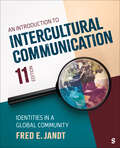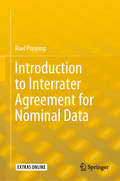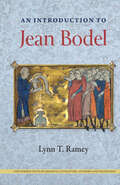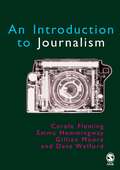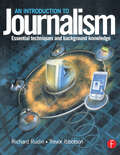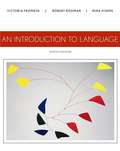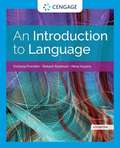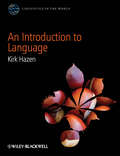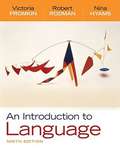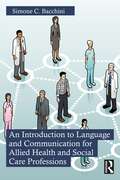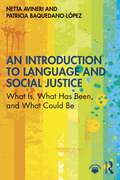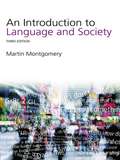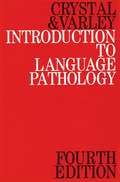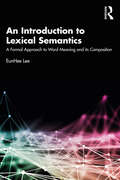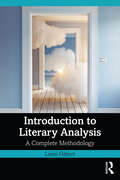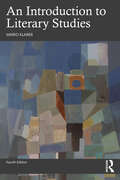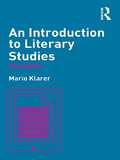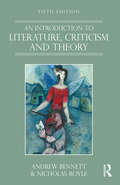- Table View
- List View
An Introduction to Intercultural Communication: Identities in a Global Community
by Fred E. JandtAn Introduction to Intercultural Communication prepares students to successfully navigate our increasingly interconnected global community by introducing essential communication skills and concepts with the goal of cultivating intercultural communication competencies when interacting with different cultures and ethnic groups. Best-selling author Fred E. Jandt offers students unique insights into intercultural communication, at home and abroad, through a focus on history, culture, and popular media. Emphasis is also placed on the important roles that stories, personal experiences, and self-reflection play in building our intercultural understanding and competence. The Eleventh Edition presents the most extensive revision of the text, including tying chapter learning objectives to the content, a new "Point/Counterpoint" feature to present both sides of controversial issues in intercultural communication to aid in developing critical thinking skills, and current examples that speak to the changing dynamics of our global community.
Introduction to Interrater Agreement for Nominal Data (SpringerBriefs in Statistics)
by Roel PoppingThis introductory book enables researchers and students of all backgrounds to compute interrater agreements for nominal data. It presents an overview of available indices, requirements, and steps to be taken in a research project with regard to reliability, preceded by agreement. The book explains the importance of computing the interrater agreement and how to calculate the corresponding indices. Furthermore, it discusses current views on chance expected agreement and problems related to different research situations, so as to help the reader consider what must be taken into account in order to achieve a proper use of the indices.The book offers a practical guide for researchers, Ph.D. and master students, including those without any previous training in statistics (such as in sociology, psychology or medicine), as well as policymakers who have to make decisions based on research outcomes in which these types of indices are used.
An Introduction to Japanese Kanji Calligraphy
by Bob Godin Takezaki KuniiThis step-by-step Japanese calligraphy book explains the systems of Japanese language and delves into details of written Japanese characters and techniques of kanji calligraphy.The word calligraphy literally means "beautiful writing." It is an art form that can be found in most civilizations with a written script. Originally developed to stress the importance of culture, religion and philosophy, over time calligraphy in most languages has developed into a purely artistic expression.In Japanese culture, kanji characters from the Japanese writing system are used in calligraphy. An Introduction to Japanese Kanji Calligraphy is an exploration of this Asian art form, and examines how calligraphic poetry developed in Japan. Written by a Japanese shodo master, it is a wonderful introduction to the beautiful art of Japanese calligraphy.Japanese Kanji Calligraphy includes:An introduction to Japanese calligraphy Background information on the modern Japanese language Hiragana and katakana charts An explanation of the tools of calligraphy A guide to correct calligraphy techniques Step-by-step calligraphy instructions An extensive kanji character library
An Introduction to Jean Bodel (New Perspectives on Medieval Literature: Authors and Traditions)
by Lynn T. RameyBringing the work of a highly influential medieval French writer to English-speaking audiences for the first time This book explores the life and works of Jean Bodel, an influential author who lived in twelfth-century Arras, France. A versatile poet, playwright, and epic writer who established new genres such as fabliaux and the mystery play, Bodel remains relatively unknown to Anglophone audiences. Lynn Ramey offers translations and summaries of works never published before in English while delving into Bodel’s historical and cultural context. After a brief introduction to the poet, Ramey highlights the stimulating and cosmopolitan environment of Arras, considering the influence of the Crusades and social movements in shaping Bodel’s works. Next, Ramey provides an extensive survey of all of Bodel’s known writing across his prolific career by genre, from his most well-known work, The Play of Saint Nicholas (Le Jeu de saint Nicolas), to his final piece, Farewell (Les Congés), which offers important insight into his diagnosis of leprosy toward the end of his life. Ramey translates several pieces including pastourelles, fabliaux, and selections from the Song of the Saxons (Chanson des Saisnes). The book also includes information on Bodel’s sources, a chronology, and a glossary. With much of the existing scholarship on Bodel only available in French, this book bridges a gap in knowledge of the poet and serves as a useful resource for both students and specialists. An Introduction to Jean Bodel allows a broader audience to engage with the writer’s wide-ranging work and contributions to literary history.A volume in the series New Perspectives on Medieval Literature: Authors and Traditions, edited by R. Barton Palmer and Tison Pugh
Introduction to Journalism
by Carole Fleming Emma Hemmingway Gillian Moore Dave Welford'The book does what it says on the label. It is punctuated throughout with useful and relevant quotes from working journalists - their opinions, tips and warnings - a technique that drives home the message and adds life and colour' -THES Textbook Guide The job of a journalist has changed dramatically over the past few decades with satellite links, 24 hour rolling news, and the Internet creating constant pressure for the latest updates. But for all that, the fundamentals of doing the job remain the same: it's about identifying a story, getting the interviews, and delivering a balanced and interesting report. 'Introduction to Journalism' examines the skills needed to work as a journalist in newspapers, television, radio and online: Provides case studies as a guide to researching stories, interviewing, and writing for each medium, as well as recording material for both radio and television. Offers a wide range of comment and tips on the best way to approach stories. Includes interviews with journalists working on a variety of news outlets from the BBC to weekly newspapers. This book provides a lively and authoritative introduction to journalism and readers will enjoy the insight from a range of journalists.
Introduction to Journalism
by John Reque Susan Hathaway Melissa Mcintosh Bryan Denham Judy Babb TantilloAs the journalism profession enters the 21st century, it faces major challenges. For one thing, the technology of journalism is changing so fast we aren't sure from one year to the next just how the news will be delivered.
Introduction to Journalism: Essential techniques and background knowledge
by Richard Rudin Trevor IbbotsonAnyone studying journalism, or training for the industry, will benefit from the broad scope of information and guidance packed into this textbook. Those already employed in journalism or related areas will also find it useful as a reference book. Essential techniques employed by journalists working across all media are supplemented with detailed sections on the workings of public administration, law, health and safety, regulation and training. Each chapter concludes with suggested learning activities and an extensive list of resources for further study and investigation. The approach throughout chapters covering background issues (e.g. law) is 'journalism centred': all topics are related to the interests and concerns of journalists and journalism. Students of the City and Guilds Diploma in Media Techniques will find the book particularly relevant to their studies as it has been developed to reflect the syllabus of this course.
An Introduction to Language
by Victoria Fromkin Robert Rodman Nina HyamsAssuming no prior knowledge of linguistics, AN INTRODUCTION TO LANGUAGE, Tenth Edition, is appropriate for a variety of fields--including education, languages, psychology, cognitive science, anthropology, English, and teaching English as a Second Language (TESL)--at both the undergraduate and graduate levels. This completely updated edition retains the clear descriptions, humor, and seamless pedagogy that have made the book a perennial best-seller, while adding new information and exercises that render each topic fresh, engaging, and current.
An Introduction To Language
by Victoria Fromkin Robert Rodman Nina M. HyamsAN INTRODUCTION TO LANGUAGE, 11th Edition, offers an up-to-date look at language studies and linguistics in today's world. This product is fresh and modern, and includes new developments in linguistics and related fields that strengthen its appeal to a wider audience. At the same time, it maintains the acclaimed light, friendly, readable style and the breadth of coverage that have made it a perennial best seller. The authors examine grammatical subjects (e.g., morphology, syntax, semantics, phonetics, phonology), childhood language development and adult secondary language acquisition, and the tremendous leap in knowledge achieved in neurolinguistics.
An Introduction to Language
by Kirk HazenAn Introduction to Language offers an engaging guide to the nature of language, focusing on how language works - its sounds, words, structures, and phrases - all investigated through wide-ranging examples from Old English to contemporary pop culture.Explores the idea of a scientific approach to language, inviting students to consider what qualities of language comprise everyday skills for us, be they sounds, words, phrases, or conversationHelps shape our understanding of what language is, how it works, and why it is both elegantly complex and essential to who we areIncludes exercises within each chapter to help readers explore key concepts and directly observe the patterns that are part of all human languageExamines linguistic variation and change to illustrate social nuances and language-in-use, drawing primarily on examples from EnglishAvoids linguistic jargon, focusing instead on a broader and more general approach to the study of language, and making it ideal for those coming to the subject for the first timeSupported by additional web resources - available upon publication at www.wiley.com/go/hazen - including student study aids and testbank and notes for instructors
An Introduction to Language (9th Edition)
by Victoria Fromkin Robert Rodman Nina HyamsAssuming no prior knowledge of linguistics, AN INTRODUCTION TO LANGUAGE, Ninth Edition, is appropriate for a variety of fields--including education, languages, psychology, anthropology, English, and teaching English as a Second Language (TESL)--at both the undergraduate and graduate levels. This completely updated edition retains the clear descriptions, humor, and seamless pedagogy that have made the text a perennial best-seller, while adding new information and exercises that render each topic fresh, engaging, and current.
An Introduction to Language and Communication for Allied Health and Social Care Professions
by Simone C. BacchiniBringing insights from linguistics to those without a background in this field, An Introduction to Language and Communication for Allied Health and Social Care Professions enables readers to better appreciate the ways in which language functions simultaneously as an instrument to encode and communicate meaning, build and sustain interpersonal relationships, and express identity. Grounded in the understanding of language as a multifunctional, interactional tool offered by sociolinguistics, pragmatics, and discourse analysis, the book: Provides readers with well-grounded tools that they can use to inform their daily work as well as to reflect upon their own communicative practices and – where necessary – to improve them Features ‘discussion points’ in the form of questions, suggestions for reflection, and small analysis tasks throughout Contains end-of-chapter summaries and suggestions for further reading An Introduction to Language and Communication for Allied Health and Social Care Professions is ideal as a core or supplementary textbook for students on degrees in public health, social work, social care, nursing, and other allied health professions who are taking courses in communication. It is also an invaluable guide for qualified health and social care practitioners, to support both their professional practice and their continuing professional development.
An Introduction to Language and Linguistics
by Ralph Fasold Jeff Connor-LintonThis accessible textbook is the only introduction to linguistics in which each chapter is written by an expert who teaches courses on that topic, ensuring balanced and uniformly excellent coverage of the full range of modern linguistics. Assuming no prior knowledge the text offers a clear introduction to the traditional topics of structural linguistics (theories of sound, form, meaning, and language change), and in addition provides full coverage of contextual linguistics, including separate chapters on discourse, dialect variation, language and culture, and the politics of language. There are also up-to-date separate chapters on language and the brain, computational linguistics, writing, child language acquisition, and second-language learning. The breadth of the textbook makes it ideal for introductory courses on language and linguistics offered by departments of English, sociology, anthropology, and communications, as well as by linguistics departments.
An Introduction to Language and Linguistics
by Ralph Fasold Elizabeth Zsiga Donna Lardiere Ruth Kramer David Lightfoot Paul Portner Deborah Schiffrin Deborah Tannen Alison Mackey Natalie Schilling Michael T. Ullman Shaligram Shukla Kendall A. King Jeff Connor-Linton Inderjeet Mani Ralph Fasold Jeff Connor-Linton Elizabeth Zsiga Donna Lardiere Ruth Kramer David Lightfoot Paul Portner Deborah Schiffrin Deborah Tannen Alison Mackey Natalie Schilling Michael T. Ullman Shaligram Shukla Kendall A. King Inderjeet ManiThis accessible textbook is the only introduction to linguistics in which each chapter is written by an expert who teaches courses on that topic, ensuring balanced and uniformly excellent coverage of the full range of modern linguistics. Assuming no prior knowledge the text offers a clear introduction to the traditional topics of structural linguistics (theories of sound, form, meaning, and language change), and in addition provides full coverage of contextual linguistics, including separate chapters on discourse, dialect variation, language and culture, and the politics of language. There are also up-to-date separate chapters on language and the brain, computational linguistics, writing, child language acquisition, and second-language learning. The breadth of the textbook makes it ideal for introductory courses on language and linguistics offered by departments of English, sociology, anthropology, and communications, as well as by linguistics departments.
An Introduction to Language and Social Justice: What Is, What Has Been, and What Could Be
by Netta Avineri Patricia Baquedano-LópezThis innovative, interdisciplinary course textbook is designed to provide the who, what, where, when, why, and how of the intersections of language, inequality, and social justice in North America, using the applied linguistic anthropology (ALA) framework. Written in accessible language and at a level equally legible for advanced undergraduate and graduate students, this text connects theory and practice by sketching out relevant historical background, introducing theoretical and conceptual underpinnings, illustrating with case studies, discussing a wide range of key issues, and explaining research methodologies. Using a general-to-specialized content structure, the expert authors then show readers how to apply these principles and lessons in communities in the real world, to become advocates and change agents in the realm of language and social justice. With an array of useful pedagogical resources and practical tools including discussion questions and activities, reflections and vignettes, further reading and a glossary, along with additional online resources for instructors, this is the essential text for students from multiple perspectives across linguistics, applied linguistics, linguistic anthropology, and beyond.
An Introduction to Language and Society (Studies In Culture And Communication Ser.)
by Martin MontgomeryIn this third edition of the bestselling classic textbook, Martin Montgomery explores the key connections between language and social life. Guiding the student through discussions on child language, accent and dialect, social class and gender, as well as a number of other topics, Montgomery provides a comprehensive and accessible introduction to the function of language in modern society. This third edition includes: new sections on dialect levelling and estuary English; hip-hop and rapping as anti-language and ‘crossing’ between Creole, Panjabi and South Asian English new material on the Gulf War and the 'War on Terror' discussions on language in internet usage and new technologies updated examples and references. With detailed suggestions for further reading and practical work for each chapter, An Introduction to Language and Society is the ideal resource for students and teachers of Communication Studies and Language Studies.
Introduction to Language Pathology
by David Crystal Rosemary VarleyThis new edition includes the introduction of the WHO distinctions between impairment, disability and handicap; an increased focus on information processing approaches to language disorders, and the introduction of revision questions as well as tutorial activities at the end of every chapter to support student learning.
An Introduction to Lexical Semantics: A Formal Approach to Word Meaning and its Composition
by EunHee LeeAn Introduction to Lexical Semantics provides a comprehensive theoretical overview of lexical semantics, analysing the major lexical categories in English: verbs, nouns, adjectives, adverbs and prepositions. The book illustrates step-by-step how to use formal semantic tools. Divided into four parts, covering the key aspects of lexical semantics, this book: introduces readers to the major influential theories including the syntax-lexical semantics interface theory by Levin and Rappaport and Pinker, the generative lexicon theory by Pustejovsky and formal semantic analyses discusses key topics in formal semantics including metonymy, metaphor and polysemy illustrates how to study word meaning scientifically by discussing mathematical notions applied to compositional semantics. Including reflection questions, summaries, further reading and practice exercises for each chapter, this accessible guide to lexical semantics is essential reading for advanced students and teachers of formal semantics.
An Introduction to Linguistics through Popular Music
by Patrice LarroqueThis textbook introduces the field of linguistics, demonstrating syntactic categories, morphological structures, phonological/metric structures, syllable structures, and varieties of English in an accessible way by using portions of song lyrics from popular music. The varieties of English covered include Received Pronunciation (RP) and General American, as well as some features of Australian English, southern US varieties, and Scottish English. Drawing on shared characteristics between language and music, including metrical structure, the author suggests a different approach to linguistic analysis and the description of spoken language. The book introduces both students and instructors to a novel and engaging method of description, and provides a fresh vocabulary with which to start thinking about language. It demonstrates complex topics by using music as a fun and familiar starting point, and will be an ideal resource for introductory linguistics courses worldwide.
Introduction to Literary Analysis: A Complete Methodology
by Louis HébertThis book provides a complete guide to analyzing literary works, from an introduction of basic principles to the finer details. Separated into three sections, the book covers: • Principles—this looks at what literary analysis is, its three main components, and the various possible objects of analysis • Main components—introduces nearly 30 aspects of text analysis, such as style, themes, social aspects, and context, and then goes on to introduce nearly 50 approaches, such as literary history, ecocriticism, narratology, and sociology • The process of analysis—details the general structure of the analytical text, the structure of a pedagogical essay, the analysis of a theoretical element, possible “plans” for the analytical text, methods of argumentation, statements of opinion, hypotheses, the structure of paragraphs, and the use of citations. This book is a synthesis of established scholarship with new, original insights, making it an ideal introduction to the study of literature as well as a valuable companion throughout further study.
An Introduction to Literary Debate in Late Medieval France: From <i>Le Roman de la Rose</i> to <i>La Belle Dame sans Mercy</i> (New Perspectives on Medieval Literature: Authors and Traditions)
by Joan E. McRaeHow medieval poems sparked discussions on women’s agency, love, marriage, and honor that prefigured modern feminism This volume immerses readers in a debate tradition that flourished in France during the late Middle Ages, focusing on two works that were both popular and controversial in their time: Le Roman de la Rose by thirteenth-century poets Guillaume de Lorris and Jean de Meun and La Belle Dame sans Mercy by fifteenth-century royal secretary and poet Alain Chartier. This is the first comparative volume on these important works and the discussions they sparked. Engaging with questions of women’s agency, love, marriage, and honor, these two poems prompted responses that circulated via treatises, letters, and sermons among officials, clerics, and poets. Joan McRae provides commentary on the two texts, a timeline and summary of the resulting debates, and biographical sketches of the leading intellectuals who matched wits over different ways of reading the texts, including pioneering writer Christine de Pizan. McRae shows that these works and the debates, read together, consider a range of social issues that raise questions of gender, the place of power and hierarchy in societal relationships, and the responsibility of writers for the effect of their works on readers. An Introduction to Literary Debate in Late Medieval France is a helpful overview of these weighty arguments for both students and scholars. McRae provides a compact, comprehensive, and up-to-date study, spotlighting influential literary expressions that evolved into the “querelle des femmes,” the “woman question,” which in turn paved the way for modern feminism. A volume in the series New Perspectives on Medieval Literature: Authors and Traditions, edited by R. Barton Palmer and Tison Pugh
An Introduction to Literary Studies
by Mario KlarerThe fourth edition of this classic beginner’s guide to literary studies has been fully updated throughout. Mario Klarer offers a concise and accessible discussion of central issues in English and world literature as well as film and television series. Starting with the basics of what constitutes a literary text, the book moves through an analysis of major genres, important periods, and key theoretical approaches to literature and film. It also looks at the practicalities of finding and referencing secondary sources when writing a research paper. The expanded new edition has been updated to include: a wider range of examples from world literature, cinema, and television series additional references to contemporary streaming formats updated chapters on postcolonial theory, cultural studies, gender theory, feminism, and queer theory new sections on digital humanities, ecocriticism, literary translations, and paratexts extended explanations of traditional genres, e.g., the epic, drama, and poetry a completely revised chapter on the most recent MLA guidelines with rules for citing new media formats The detailed glossary ensures that the book is accessible to readers of any level, making this an ideal self-study guide or a course book for Introduction to Literature classes.
An Introduction to Literary Studies
by Mario KlarerIn this classic beginner's guide to English literature, Mario Klarer offers a concise and accessible discussion of central issues in the study of literary texts, looking at: definitions of key terms such as literature and text the genres of fiction, poetry, drama, and film periods and classifications of literature theoretical approaches to texts the use of secondary resources guidelines for writing research essays The new and expanded edition is fully updated to include: a wider range of textual examples from world literature additional references to contemporary cinema, a section on comparative literature an extended survey of literary periods and genres recent changes in MLA guidelines information on state-of-the-art citation management software the use and abuse of online resources. The book also features suggestions for further reading as well as an extensive glossary of key terms.
Introduction to Literature: The Start of Something Great
by Kathleen T. DanielFresh, original and compelling, An Introduction to Literature is the essential guide to literary studies. Starting at 'the beginning' and concluding with 'the end', the book covers topics that range from the familiar (character, narrative, the author) to the more unusual (secrets, pleasure, ghosts).
An Introduction to Literature, Criticism and Theory
by Andrew Bennett Nicholas RoyleLively, original and highly readable, An Introduction to Literature, Criticism and Theory is the essential guide to literary studies. Starting at ‘The Beginning’ and concluding with ‘The End’, chapters range from the familiar, such as ‘Character’, ‘Narrative’ and ‘The Author’, to the more unusual, such as ‘Secrets’, ‘Pleasure’ and ‘Ghosts’. Now in its fifth edition, Bennett and Royle’s classic textbook successfully illuminates complex ideas by engaging directly with literary works, so that a reading of Jane Eyre opens up ways of thinking about racial difference, for example, while Chaucer, Raymond Chandler and Monty Python are all invoked in a discussion of literature and laughter. The fifth edition has been revised throughout and includes four new chapters – ‘Feelings’, ‘Wounds’, ‘Body’ and ‘Love’ – to incorporate exciting recent developments in literary studies. In addition to further reading sections at the end of each chapter, the book contains a comprehensive bibliography and a glossary of key literary terms. A breath of fresh air in a field that can often seem dry and dauntingly theoretical, this book will open the reader’s eyes to the exhilarating possibilities of reading and studying literature.
